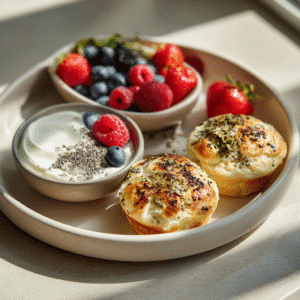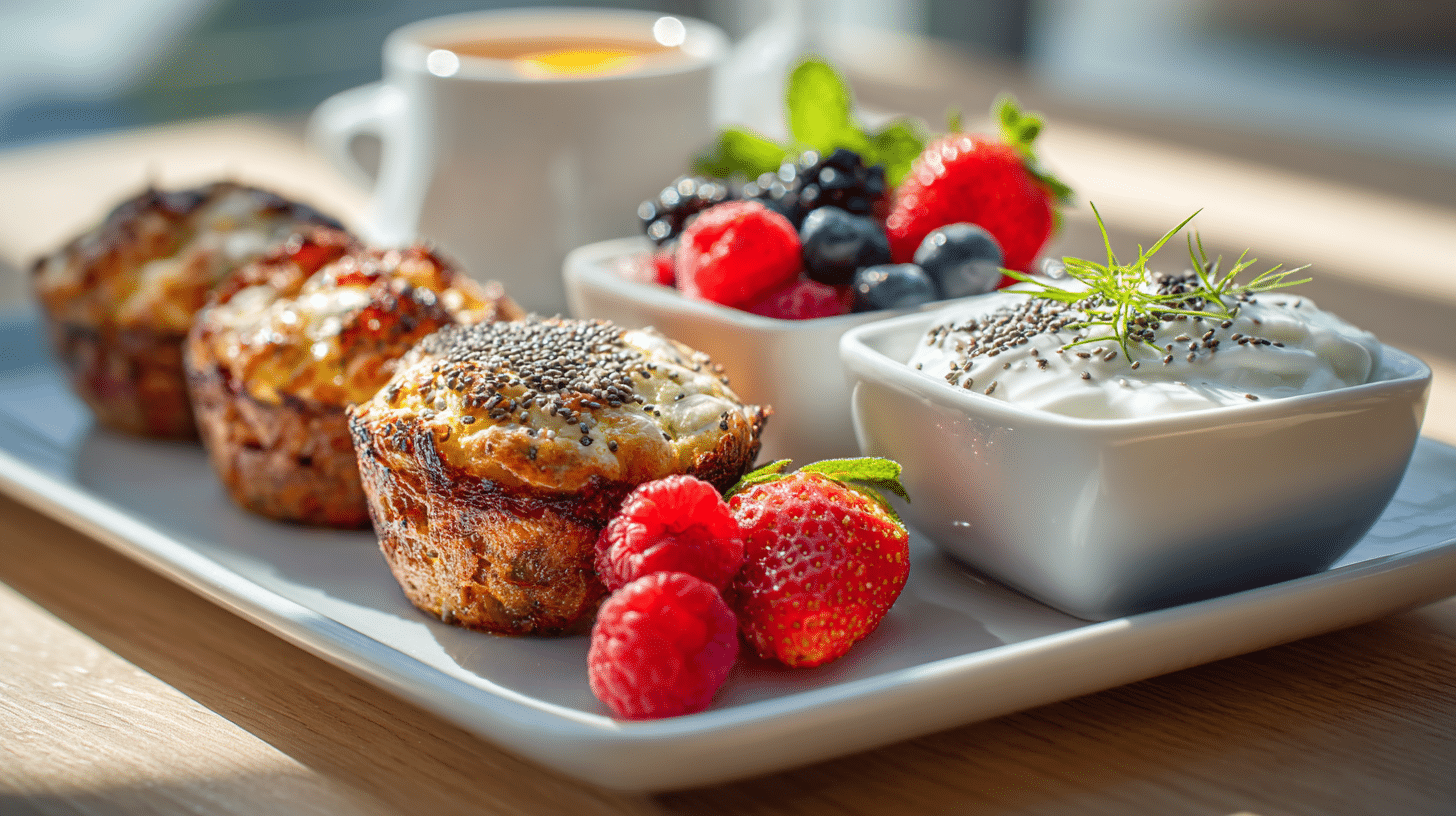
Starting your day with high-protein gluten-free breakfasts is more than just a health trend. It’s a practical approach to fueling your morning with energy while avoiding gluten. Whether you’re managing celiac disease, gluten intolerance, or just aiming for more protein in your diet, this article will guide you through easy meal ideas, pantry essentials, meal prep tips, and more. From protein-packed smoothie bowls to kid-approved recipes, you’ll find useful ideas that are quick, balanced, and delicious.
Why High-Protein Gluten-Free Breakfasts Matter
Gluten-Free Doesn’t Mean Low Nutrition
High-protein gluten-free breakfasts are not just safe for those avoiding gluten—they’re packed with real nutrition. Many naturally gluten-free foods, like eggs, beans, and Greek yogurt, deliver quality protein without processed carbs. When chosen wisely, gluten-free meals can be even more nutrient-dense than typical breakfasts.
Often, gluten-free packaged foods—like waffles or toast—lack real protein. Replacing those with high-protein gluten-free breakfasts that use whole foods ensures better balance. You’ll skip the sugar spikes and keep your body fueled the right way.
Protein Keeps You Full Longer and Boosts Energy
High-protein gluten-free breakfasts help you stay full and focused. They slow digestion, which means fewer blood sugar crashes and better energy throughout the morning. Unlike carb-heavy meals, protein supports muscle repair and keeps your appetite in check.
Research shows that 30 to 40 grams of protein in the morning can improve metabolism and support lean muscle mass. When you combine that with gluten-free grains, fruits, or vegetables, you get meals that are clean, filling, and packed with lasting energy.
Essential Ingredients for High-Protein Gluten-Free Meals
Naturally Gluten-Free Protein Sources (Eggs, Greek Yogurt, Tofu)
When planning high-protein gluten-free breakfasts, it starts with ingredients that naturally contain both protein and zero gluten. Eggs are one of the easiest go-to choices. Scrambled, boiled, or in muffins—they deliver 6 to 7 grams of protein per egg with no added carbs.
Greek yogurt (unsweetened) is another standout. Just one cup provides up to 20 grams of protein. For a dairy-free option, firm tofu is versatile and absorbs any flavor. Stir-fried with vegetables or blended into a smoothie, it adds a rich protein punch without gluten.
Other excellent choices include tempeh, cottage cheese, and protein-fortified plant-based milk like pea or soy. These foods are naturally gluten-free and easy to mix into many breakfast dishes.
Pantry Staples to Support Easy Protein Boosts (Chia, Quinoa, Nut Butters)
To make high-protein gluten-free breakfasts easier to assemble daily, stock your pantry with supportive staples. Chia seeds are a tiny powerhouse—offering 5 grams of protein per 2 tablespoons, plus fiber and omega-3s. Soaked overnight in milk, they turn into delicious, thick pudding bases.
Quinoa is one of the few plant foods that provide all nine essential amino acids. Cook a batch ahead of time and add it to breakfast bowls or use it in muffins. Peanut butter, almond butter, and sunflower seed butter all contain 7–9 grams of protein per serving, making them perfect for toast, smoothies, or pancake toppings.
Other handy items to have on hand include hemp hearts, unsweetened protein powders, and canned beans. With these, you can easily reach your protein goals while keeping breakfast 100% gluten-free.
Many people assume gluten-free eating means missing out on flavor or fullness, but that’s not true—especially when you start with meals like Healthy Gluten-Free Egg Muffins. These muffins are a protein-packed solution that proves high-protein gluten-free breakfasts can be both satisfying and simple to make ahead.
Easy High-Protein Gluten-Free Meal Ideas
5-Minute Greek Yogurt Bowl with Seeds and Berries

When mornings feel rushed, fast high-protein gluten-free breakfasts can save the day. Start with plain Greek yogurt for the base—thick, creamy, and packed with up to 20 grams of protein. Top it with fresh berries, which add antioxidants, and a spoonful of chia or flax seeds for texture and fiber.
Drizzle almond butter or peanut butter on top for a delicious boost. Add gluten-free granola for crunch if you like. This quick bowl gives you a balance of protein, healthy fats, and carbs—all without gluten or cookinGreek Yogurt Bowl & Scrambled Eggs with Spinach and Chickpeasg.
Scrambled Eggs with Spinach and Chickpeas

This hearty option is one of the best warm high-protein gluten-free breakfasts you can make in under 10 minutes. Scramble 2–3 eggs in olive oil, then toss in a handful of chopped spinach and half a cup of cooked chickpeas. Chickpeas bring fiber and plant protein, while spinach adds iron and vitamins.
Season with salt, pepper, garlic, or even a dash of cumin. Want more variety? Add chopped tomatoes or mushrooms. Serve it alone or over gluten-free toast to make it more filling. This savory breakfast will easily keep you full for hours.
Meal Prep Strategies for Busy Mornings
Batch Cooking Egg Muffins and Protein Pancakes

Meal prepping is essential for those who want to enjoy high-protein gluten-free breakfasts without daily hassle. Egg muffins are perfect for batch cooking. Whisk eggs with veggies like bell peppers and spinach, pour into muffin tins, and bake. These can be stored in the fridge for up to five days and reheated quickly in the morning.
Protein pancakes made with gluten-free flour blends and added protein powder or eggs also store well. Make a large batch on the weekend, then freeze individual portions. Reheat in the toaster or microwave for a fast, filling meal.
Make-Ahead Overnight Chia Pudding with Nut Toppings

Overnight chia pudding is another excellent option for meal prepping high-protein gluten-free breakfasts. Mix chia seeds with your choice of dairy or plant-based milk and a scoop of protein powder if desired. Leave it in the fridge overnight, and it will thicken into a creamy pudding by morning.
Top it with nuts like almonds or walnuts and fresh fruit for extra nutrients and texture. This pudding requires almost zero morning effort but delivers sustained energy and satisfying protein to start the day.
Getting 30–40g of Protein Without Gluten
Combining Protein Sources for 30–40g Meals

Hitting 30 to 40 grams of protein at breakfast without gluten is achievable by combining various protein-rich foods. For example, pair two eggs (12–14g protein) with a half-cup of cooked quinoa (4g protein) and two tablespoons of nut butter (7g protein). This mix provides a balanced, filling meal that meets high-protein gluten-free breakfasts needs.
Including dairy or plant-based yogurts with added seeds and nuts can further boost protein totals. Remember, spreading protein intake among multiple sources helps your body absorb nutrients better while keeping the meal interesting and flavorful.
Sample 40g Protein Gluten-Free Breakfast Plan
Here’s a simple meal plan to reach 40 grams of protein while staying gluten-free:
- 3 scrambled eggs (18g protein)
- 1/2 cup cooked quinoa (4g protein)
- 1/4 cup cottage cheese (7g protein)
- 1 tablespoon chia seeds (3g protein)
- 1 tablespoon almond butter (4g protein)
This combination totals 36 grams, which rounds up close to 40 grams, offering plenty of energy and satisfaction. Adjust portion sizes or add a protein smoothie to hit your exact target.
Don’t forget to enjoy something sweet without sacrificing your diet goals. If you want a high-protein snack that feels like dessert, Chocolate Delight is an excellent choice. It fits perfectly into a balanced day of eating, even alongside your favorite high-protein gluten-free breakfasts.
Gluten-Free Protein Smoothie Bowls
High-Protein Smoothie Ingredients to Use
Smoothie bowls make tasty, convenient high-protein gluten-free breakfasts. To boost protein content, start with a base of Greek yogurt or unsweetened plant-based protein milk. Add protein powder made from pea, rice, or whey (if dairy is tolerated) for an extra protein hit.
Frozen fruits like berries, mango, and banana provide natural sweetness and fiber. Add nut butters, chia seeds, or hemp hearts for texture and a protein boost. Leafy greens like spinach or kale also blend well and add vitamins without affecting flavor.
Example Smoothie Bowl Recipe for 30g Protein

Here’s a quick recipe for a high-protein gluten-free breakfast smoothie bowl:
- 1 cup Greek yogurt (20g protein)
- 1/2 banana
- 1/2 cup mixed berries
- 1 scoop plant-based protein powder (15g protein)
- 1 tablespoon chia seeds (3g protein)
- 1 tablespoon almond butter (4g protein)
Blend until smooth and pour into a bowl. Top with sliced almonds and fresh berries. This bowl totals over 30 grams of protein and provides fiber and antioxidants, making it a balanced and satisfying breakfast option.
Kid-Friendly High-Protein Gluten-Free Breakfasts
Peanut Butter Banana Oat Muffins (Gluten-Free)

Getting kids to enjoy high-protein gluten-free breakfasts can be simple with tasty treats like peanut butter banana oat muffins. Use gluten-free oats as the base and add mashed bananas for sweetness. Mix in peanut butter for protein and healthy fats. Eggs and a scoop of protein powder boost the protein content further.
Bake these muffins ahead of time for grab-and-go options that kids love. They are filling, naturally sweet, and free from gluten, making them an excellent choice for busy mornings.
Protein Pancake Bites with Berries

Another fun option is protein pancake bites. Prepare pancake batter with gluten-free flour and add protein powder or cottage cheese for extra protein. Cook small pancakes and top with fresh berries or a dollop of Greek yogurt.
These bite-sized pancakes encourage kids to eat protein-rich breakfasts while enjoying familiar flavors. They also freeze well, making breakfast prep even easier.
Mistakes to Avoid on a Gluten-Free High-Protein Diet
Relying Too Much on Processed Gluten-Free Items
While high-protein gluten-free breakfasts are easy to prepare with whole foods, many fall into the trap of buying overly processed gluten-free products. Gluten-free cereal bars, pastries, or bread replacements often lack protein and include excess sugar or fillers.
These items may be labeled “gluten-free” but don’t always support protein goals. Stick with ingredients that naturally offer both: eggs, legumes, dairy, tofu, and nuts. Reading labels carefully ensures you’re truly getting a nourishing start to the day.
Skipping Whole Food Protein Sources
One of the biggest mistakes is skipping protein-rich whole foods altogether. Many people focus only on gluten-free carbs like rice cakes, fruit, or corn-based products in the morning. While these provide energy, they don’t keep you full.
High-protein gluten-free breakfasts should always include a complete protein source. Eggs, yogurt, and lentils are great options. Without them, you may feel hungry within an hour and end up overeating later in the day. Prioritizing these ingredients builds a better, longer-lasting meal.
FAQs
What can I eat for breakfast if I’m gluten-free?
You can enjoy plenty of delicious options. Focus on naturally gluten-free foods like eggs, Greek yogurt, cottage cheese, chia pudding, and quinoa. For easy high-protein gluten-free breakfasts, combine these with fruits, vegetables, or nut butters. Smoothies, egg muffins, and overnight oats (made with certified gluten-free oats) are also great choices.
How can I get 40g of protein for breakfast?
To reach 40 grams of protein, combine multiple sources. Start with three eggs (18g), add a cup of Greek yogurt (20g), and a spoonful of nut butter (4g). These pair well in meals like savory egg bowls or Greek yogurt parfaits. High-protein gluten-free breakfasts can also include a scoop of protein powder in smoothies or baked goods.
How to get 30g protein at breakfast?
Getting 30 grams of protein is easier than you think. Mix 2 eggs (12g), half a cup of cottage cheese (14g), and chia seeds or nuts. Another option is a smoothie with protein powder, almond butter, and Greek yogurt. These combinations deliver complete, satisfying high-protein gluten-free breakfasts that keep you full longer.
What are the best gluten-free breakfasts?
The best gluten-free breakfasts include a balance of protein, fiber, and healthy fats. Try egg muffins, chia pudding with fruit and seeds, tofu scrambles, or smoothie bowls with added protein. The best high-protein gluten-free breakfasts use whole ingredients to fuel your body and reduce mid-morning hunger.
Conclusion
High-protein gluten-free breakfasts are practical, tasty, and simple to prepare. From smoothie bowls and egg muffins to overnight chia pudding, your options are wide and satisfying. When you combine smart ingredients like eggs, yogurt, tofu, nuts, and seeds, you’ll hit your protein goals without relying on gluten-based foods.
If you’re looking for more inspiration or recipe visuals, check out our latest breakfast boards on Pinterest, browse behind-the-scenes prep tips on Tumblr, follow daily updates on X (Twitter), or read extended food stories on Medium. These platforms offer even more ideas to help you create high-protein gluten-free breakfasts you’ll actually look forward to.
Meet Emily Culino
Emily Culino is a home cook, food content creator, and founder of Easy Cooking US. With a passion for gluten-free living and simple, protein-packed meals, she shares practical recipes designed for busy mornings and real-life kitchens. Her work blends flavor, nutrition, and everyday convenience—making high-protein gluten-free breakfasts both achievable and delicious for everyone.
Table of Contents

Peanut Butter Banana Oat Muffins (Gluten-Free)
Equipment
- mixing bowl
- whisk or fork
- muffin tin
- oven
- measuring cups and spoons
Ingredients
- 2 ripe bananas, mashed
- 2 eggs
- 1/2 cup natural peanut butter
- 1 cup gluten-free oats
- 1 scoop vanilla protein powder (optional)
- 1/2 tsp baking soda
- 1/2 tsp cinnamon (optional)
- 1 tsp vanilla extract
- 1/4 tsp salt
Instructions
- Preheat oven to 350°F (175°C) and grease or line a muffin tin.
- In a bowl, mash the bananas and whisk in eggs, peanut butter, and vanilla extract until smooth.
- Add oats, protein powder, baking soda, cinnamon, and salt. Stir until combined.
- Divide the mixture evenly into muffin cups (about ¾ full each).
- Bake for 18–20 minutes or until a toothpick comes out clean. Let cool before serving.

